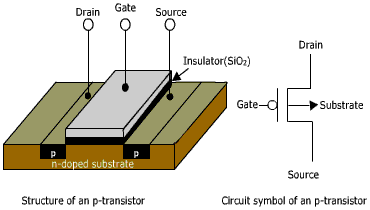A p-channel transistor, on the other hand, is made of an n-substrate separating two diffused p-type islands. Like an n-transistor, it too has a gate electrode. Apart from the gate electrode, an nMOS transistor has two more terminals known as the source and the drain which connect the two n-diffused regions (p-diffused regions in a pMOS transistor) with the external environment of the device. The gate acts as a control input, regulating the current flow between the source and the drain. Although the source and the drain are physically equivalent, the name source is reserved for the terminal by which the current carriers enter the device, whereas the drain refers to the terminal by which the carriers leave the device. As shown in Figure 1.1, the substrate (also called the body) happens to be the fourth terminal of a MOS transistor.


